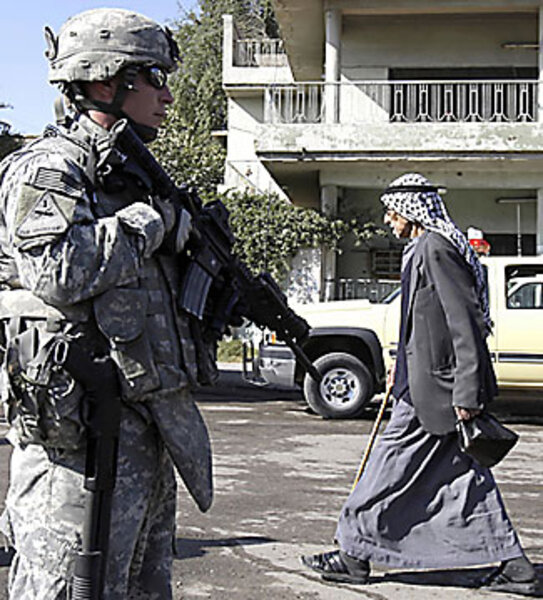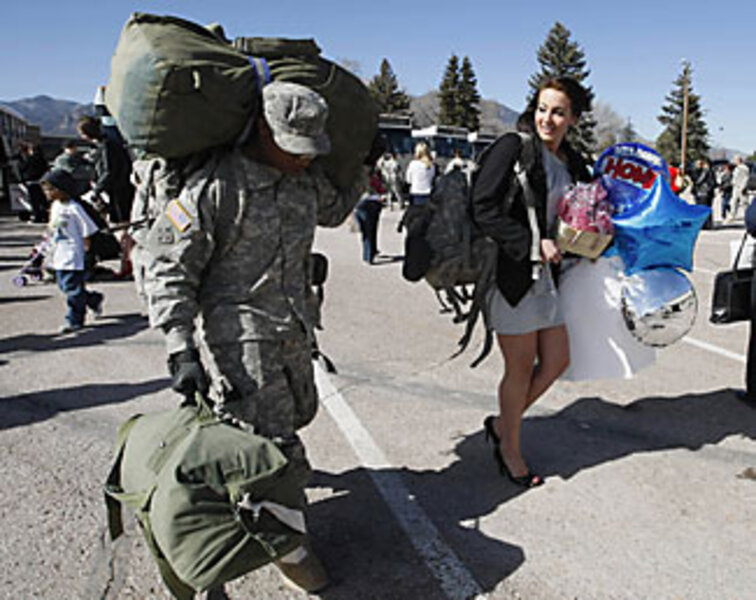Obama adjusts timing on Iraq withdrawal
Loading...
| Washington and baghdad
President Obama appears to be striking a compromise between his political commitments and the tactical views of his senior military commanders in favoring a 19-month withdrawal plan for Iraq.
The drawdown plan Mr. Obama is set to announce in the next week is likely to have most US troops leaving Iraq by mid-2010. This is slightly later than the 16-month withdrawal plan his presidential campaign had promised and reflects Obama's willingness to listen to his military commanders, some of whom want a slower drawdown.
The significance of the decision is also tempered by how much wiggle room the new commander in chief leaves himself on two issues: how he chooses to respond to changing security conditions on the ground in Iraq, and the size of a residual force to be left in Iraq for the years to come.
The move strikes the right balance, say some. "This seems to be in many ways the best compromise for this particular point in time," says Tony Cordesman, a senior fellow at the Center for Strategic and International Studies, a think tank in Washington. "If conditions change, then we have to rethink it."
The decision in favor of a 19-month withdrawal was first reported by the Associated Press Tuesday, and senior military officials have confirmed it. However, one US defense official warns that no decision has been made yet and that the White House and Pentagon are still in "recommendation mode."
Obama is also expected to announce a new way ahead in Afghanistan in the coming weeks. Last week, the White House announced that it would send up to 17,000 additional troops to the war in Afghanistan by summer even as it debates how to marry the extra forces with a new strategy.
There are currently about 142,000 American troops in Iraq, which includes 14 combat brigades and thousands of support troops. Military commanders had presented Obama with alternative scenarios for different withdrawal timelines, including plans for drawing down troops in 16 months, 19 months, and 23 months. The last was closest to the one favored by Gen. Ray Odierno, the top US commander in Iraq.
In Iraq, the decision on withdrawal is less significant than the one Obama will have to make by 2010 – how many American forces will stay on.
Some military commanders have said the US should leave as many as 35,000 to 50,000 troops in Iraq to advise and train the Iraqi security forces. The Obama White House may not indicate the size of that residual force might be any time soon, however, as any number could be immediately criticized by the American and Iraqi public. "We would be out of our mind to specify a residual force," says Mr. Cordesman.
One Iraqi official says the US and Iraq have not yet begun negotiations on the size of the residual force, adding that the Obama administration, currently focused on the American economy and ramping up operations in Afghanistan, was far less engaged with Iraq policy than the previous administration.
"[T]he key is what will we be doing to retain a residual force and a strategic posture to help if problems arise," says the official, who did not want to speak publicly about the withdrawal plan before it was announced.
Indeed, American troops are already pulling back out of Iraqi cities and gradually reducing their visibility on Iraqi streets, acting more as "firemen" and responding to security situations as needed.
"The Americans are not what they used to be here six months ago, four months ago," the Iraqi official says. "Basically they are letting go in a way but definitely we have to have a sustained presence here for a long time because without this it could unravel."
The Bush administration had largely been opposed to withdrawal timelines, arguing that insurgents would either wait out an American withdrawal to foment more unrest – something they could do anyway – or use the date to undermine security gains made over the previous year. Before President Bush left office, however, he appeared to have resigned himself to a drawdown within an unspecified period of time. Two key agreements, the Status of Forces agreement, which codifies the legal framework for US troop presence, and the Strategic Agreement, which includes outlines on how and when American forces would engage in combat, were signed last year, requiring combat forces to be out by the end of 2010.
Political leaders and military commanders in Iraq are most worried about areas of the country with political and demographic tensions that have proved more resistant to the "surge" of American and Iraqi forces in early 2007. Iraqi officials have asked US forces to stay in some areas like Mosul and Diyala in the north.
"We won't be able to keep peace in Mosul without the Americans," says another Iraqi official.
Although some Iraqi politicians publicly demand an immediate withdrawal of American forces, a move that would be popular on the street, privately they appear to agree on the need for a sustained American presence, albeit one with a lower profile.
"We have been reassured by the new administration that there will not be a major change, or a quick disengagement or quick pullout from Iraq," Iraq Foreign Minister Hoshyar Zubari told reporters earlier this month.
Both American and Iraqi officials have long believed the US would have a sustained advisory role in Iraq for years to come, despite Obama's campaign rhetoric. The US has trained as many as 565,000 Iraqi security forces, including both army, police and border forces, as of last fall. Although that force has made progress over the years, US and Iraqi officials believe much work remains to be done.
The US has remained in countries in which it has engaged in past wars: There are still about 28,000 troops stationed in North Korea and another 54,000 in Germany.
The ultimate answer to how many American forces remain there may largely be up to the Iraqis, the US defense official says.
"The Iraqis themselves are key to answering those questions."






